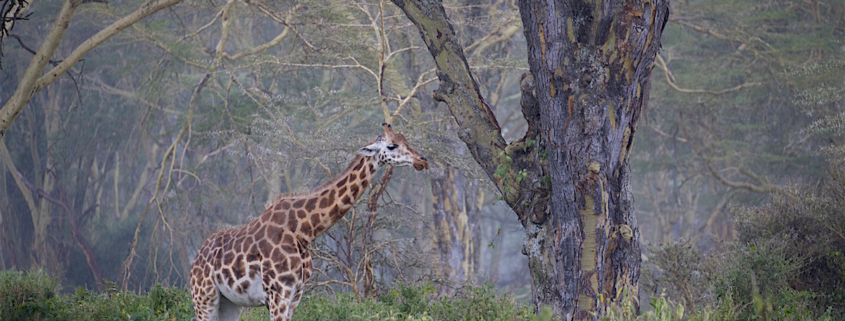Bon appetit or as the leopard says: “Bone up a tree”
We just finished a 3 week long amazing Wild Focus Expeditions safari in Tanzania and Kenya. It started with rain and tall grass in Tarangire National Park in Tanzania. Nobody had expected to find this scenic park about 2 driving hours south of Arusha to be so lush this time of the year. Zebras and wildebeest, usually in high numbers, avoided the wet terrain and had moved to the drier areas around Lake Manyara. Yet will still enjoyed exciting sightings with elephants, giraffes and buffalo for 2 days before heading to world famous Ngorongoro Crater where we spent 2 days photographing four of the Big Five with the majestic back drop of the crater rim. From our lodge at an altitude of 2300 m down to the crater bottom we covered a drop of 600 m driving through lush acacia forest on the crater slope.
On the way to our next stop, Ndutu, we passed tens of thousands of wildebeest that had followed the rains in order to give birth in this fertile grassland. It is here in the Ngorongoro Conservation Area where the wildebeest migration begins its yearly cycle. Due to the mineral rich volcanic soil the grass is full of important nutrients that are essential for producing strong and healthy calves.
In Ndutu we were not disappointed by big cat action. Here we saw the first cheetahs on this trip and even witnessed a cheetah taking down a lone wildebeest calf directly in front of one of our vehicles. On the same day everybody in the group “chimped” when 7 small lion cubs suckled at their mothers a few meters away from us. All 4 days in Ndutu were filled with excitement and the 8-9 hours per day we spent in our game drive vehicles seemed much too short.
Our next destination was Seronera in the central Serengeti. Again we were surrounded by tall grass and wildlife sightings were not as frequent as in Ndutu. But because of the tall grass big cats preferred spending the daytime in shady trees. Never have I seen so many leopards and lions in trees.
From Seronera we took a plane to Kilimanjaro Airport and continued via Nairobi to Samburu in the northern part of Kenya. We hadn’t seen a leopard yet but I promised my guests that the chances to spot this beautiful cat, the last of the Big Five, here in Samburu were good. And they turned out to be better than I have ever experienced before. We saw a young leopard pulling an impala kill up a tree while the mother was watching. The next day we found another female in a tree and later in the afternoon on an impala kill. The next morning her cub had joined her for breakfast – 4 leopards in 2 days! Not too shabby!
 Although we had already seen rhinos in Ngorongoro Crater the distance was too great for decent photographs. But the private reserve, Solio Ranch, kept its promise to be one of the best places in Kenya to get up close to these powerful animals. Again we were surprised by a spectacular sighting of a black rhino and white rhino fighting each other for hours.
Although we had already seen rhinos in Ngorongoro Crater the distance was too great for decent photographs. But the private reserve, Solio Ranch, kept its promise to be one of the best places in Kenya to get up close to these powerful animals. Again we were surprised by a spectacular sighting of a black rhino and white rhino fighting each other for hours.
Yesterday we came back to Nairobi from our last stop – Nakuru National Park. Until a few years ago it was famous for its large numbers of flamingos; today the lake hosts only a few of the graceful pink birds due to high water levels. But even without a sea of pink, Nakuru National Park is well worth a visit. We had fantastic giraffe sightings of the Rothschild’s giraffe, the rarest of the 3 giraffe species, not to mention large herds of buffalo, zebras, impalas and the ever present olive baboons.
 I am writing this blog from Schipol Airport in Amsterdam waiting for my flight to Atlanta. Despite a very exciting safari I can’t wait to finally be back home again with Jami and Gershwin.
I am writing this blog from Schipol Airport in Amsterdam waiting for my flight to Atlanta. Despite a very exciting safari I can’t wait to finally be back home again with Jami and Gershwin.




Leave a Reply
Want to join the discussion?Feel free to contribute!